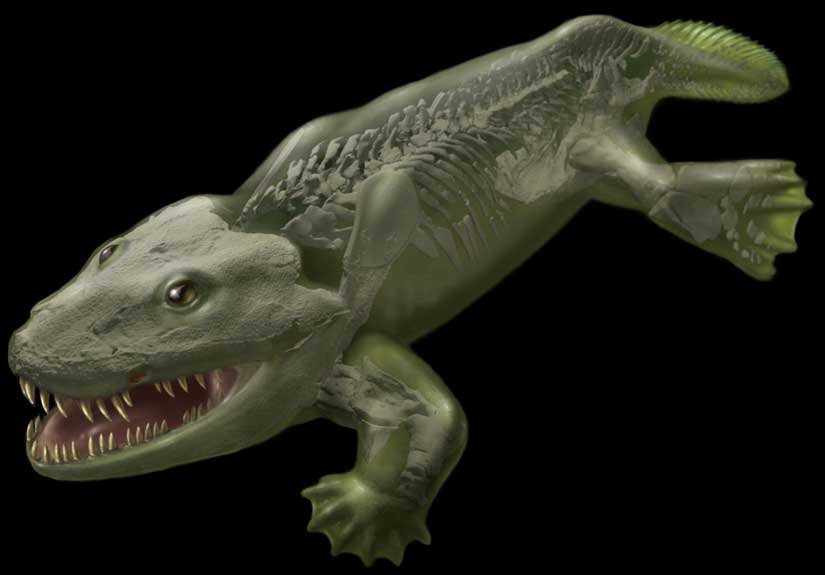First Terrestrial Animals Shuffled Onto Land

The transition from swimming to walking involved some awkward first steps, according to a new study that recreated how one of the first animals, which left the sea for land, moved.
The study found that that the fishy four-limbed animal Ichthyostega used its front limbs like crutches, pushing its body up and forward onto land while its legs and tail trailed behind. It lived in water near the shoreline when not on land.
This was one small step for sea creatures but one big step for animal kind, because those early movements on land around 374-359 million years ago likely later evolved into walking, including human locomotion.
"Ichthyostega's muscular and mobile elbows would have also assisted in station holding (staying in one spot) while in the water and in lifting its head out of the water to breathe and process food," Stephanie Pierce of the Royal Veterinary College's Structure and Motion Laboratory told Discovery News.
"Ichthyostega probably used its paddle-like legs and tail to swim while in the water," she added. "The hind legs probably were not of much use on land, especially compared to the forelimbs."
Pierce and her colleagues Jennifer Clack and John Hutchinson reconstructed the first ever 3-D computer model of the tetrapod's skeleton. Ichthyostega, in addition to having big muscles, possessed huge fang-like teeth and probably ambushed its prey.
The model, which put together the fossils like a jigsaw puzzle in animation software, revealed that most books and museum displays showing Ichthyostega are incorrect. They usually represent this beast marching around like a large salamander with stocky legs.
Get the world’s most fascinating discoveries delivered straight to your inbox.
Instead, the reconstruction determined that the shoulder and hip joint of this species prevented a conventional walking step, since its limbs were incapable of rotating along its long-axis. This motion is critical to locomotion for us and other modern land animals.
Earlier fish relatives of Ichthyostega and other tetrapods, called tetrapodomorphs, had the ability to rotate their fins. This allowed later animals to move well on land. The research was published in this week's issue of Nature.
A separate study, published in the Proceedings of the Royal Society B, looked at a 345-million-year-old eel called Tarrasius problematicus. Lauren Sallan of the University of Chicago discovered that this eel had a spine with multiple segments, similar to that of today's land-dwelling animals.
Together, the two new studies offer strong evidence that some of the basic anatomical features needed for land life first evolved in sea dwellers. These features initially were used to improve swimming, but were later applied to moving around on land.
Sallan told Discovery News that the Nature paper is in agreement with her findings, "where axial regionalization is also suggested to be an adaptation for swimming." In water, the hind limbs and tail would have worked similar to those of today's tadpoles.
It remains a mystery as to why some marine species left the water for land in the first place, but Pierce thinks the food and other offerings were likely too good to pass up. Since these animals were possibly the first to even go on to land, the competition for the food -- at least from other bony species -- would have essentially been non-existent.
Pierce and her team next plan to study the mobility of the spine of Ichthyostega. This may better determine how the not-so-smooth early locomotion on land evolved into walking and running.
This story was provided by Discovery News.


